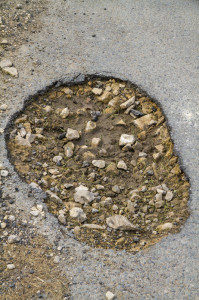Repairing tarmac drives promptly saves you time and money.
Paving your driveway is often a sizeable investment so when tarmac repair is needed it is best to do it quickly. This will prevent your driveway from getting worse which could end up costing you even more to repair.
 There are several defects that show up over time that are fairly common to tarmac driveways. These include:
There are several defects that show up over time that are fairly common to tarmac driveways. These include:
- Cracking.
- Potholes.
- Fuel and/or oil spillage.
Caught early enough these small tarmac repairs can be handled by most handymen by using cold tarmac repair.
Tarmac Repair to Driveway Cracks
There are several different types of cracks that could affect you as a driveway owner. The type of crack is dependent on what the problem with the driveway is.
It is important however that you try and seal all cracks that are a quarter of inch across or bigger. Failure to seal them will allow water to go in and damage the underlying foundation layers. Your driveway will then deteriorate even further and require more than just the basic tarmac repair products. DIY tarmac repair would also be out of the question and expensive professionals would be needed to fix it.
These cracks are:
- Reflective
- Alligator or crocodile depending on which part of the world you live in
- Thermal
- Block
- Linear
- Edge
Reflective Cracking
These are cracks that have come through the tarmac surface from the underlying foundation layers. Movement in the underlying layer causes the cracking. The direction of the crack can be longitudinal, transverse, diagonal and even block shaped and generally follows straight lines. The use of cement to strengthen the layers below the tarmac surface will cause this type of cracking to occur.
Alligator or Crocodile Cracking
These cracks are interconnected and take on the appearance of chicken wire or look like the skin of a crocodile. Tor the underlying foundation layer may have been substandard quality or saturated with water. The tarmac as it ages becomes brittle and cracks. Crocodile cracking generally starts off as small localized areas. These should be repaired quickly before they spread and become potholes or worse.
Thermal Cracking
These cracks are at right angles to the centerline of your driveway and are transverse. They are caused by the shrinking or the contracting of the tarmac surface because of low temperatures. As the temperature falls the surface contracts and because the bitumen binder is unable to relieve the stresses the surface cracks.
Block Cracking
With block cracking your tarmac driveway becomes divided into square or rectangular sections. These can vary in size from a square foot to up to ten square feet. The cause of this is the underlying foundation layer or layers not being compacted as well as they should be.
Linear Cracking
Unless you have a particularly wide drive way it is unlikely yours will suffer from linear cracking. The most common reason for this happening is the difficulty in properly compacting the joint between two lanes of paving.
Edge CracksThese are quite a common problem with driveways. Often the edges of a driveway construction are not compacted to the same quality as the rest of it. Over time the edges fall away and cause the cracking.
These are the main types of cracking that you could experience with your driveway. The most important thing you can do if you come across them is to do the tarmac repair quickly. Leaving them will allow water to get in and further deterioration to take place.
Potholes
Potholes come in all sorts of shapes and sizes. They will often start life as a small crack allowing water to get into the base and progressing from there. Other factors like poor materials, a lack of drainage, too thin a surface, badly compacted foundation layers and even poor driveway maintenance can also cause them. Repairing potholes as they occur will prevent a bad situation getting worse.
Using a tarmac repair kit or tarmac repair bags to patch them is easy enough for most home owners to do
Fuel/Oil Spillage
This can be a big problem particularly if your car is an older model and prone to the odd oil leak here and there. If you can’t stop the leaks then you need to manage them. Place a tray under your vehicle whenever it is parked on your driveway.
On areas where leaks have already occurred it is best to remove the affected area by digging a nice square hole. Then you can patch it with one of the many available brands of tarmac repair kits. If these areas are left to themselves they will develop into potholes. More extensive and expensive repair work will then be needed.
The bottom line when it comes to tarmac repair is, do it as soon as the need for it is evident. This will save you time and money.